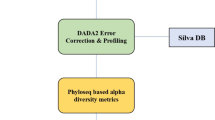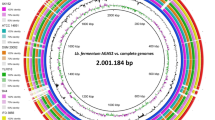Abstract
The Prevotellas comprise a diverse group of bacteria that has received surprisingly limited attention at the whole genome-sequencing level. In this communication, we present the comparative analysis of the genomes of Prevotella ruminicola 23 (GenBank: CP002006) and Prevotella bryantii B14 (GenBank: ADWO00000000), two gastrointestinal isolates. Both P. ruminicola and P. bryantii have acquired an extensive repertoire of glycoside hydrolases that are targeted towards non-cellulosic polysaccharides, especially GH43 bifunctional enzymes. Our analysis demonstrates the diversity of this genus. The results from these analyses highlight their role in the gastrointestinal tract, and provide a template for additional work on genetic characterization of these species.




Similar content being viewed by others
References
Avgustin G, Wallace RJ, Flint HJ (1997) Phenotypic diversity among ruminal isolates of Prevotella ruminicola: proposal of Prevotella brevis sp. nov., Prevotella bryantii sp. nov., and Prevotella albensis sp. nov. and redefinition of Prevotella ruminicola. Int J Syst Bacteriol 47:284–288
Barrangou R, Fremaux C, Deveau H, Richards M, Boyaval P, Moineau S, Romero DA, Horvath P (2007) CRISPR provides acquired resistance against viruses in prokaryotes. Science 315:1709–1712
Bryant MP, Small N, Bouma C, Chu H (1958) Bacteroides ruminicola n. sp. and Succinimonas amylolytica; the new genus and species; species of succinic acid-producing anaerobic bacteria of the bovine rumen. J Bacteriol 76:15–23
Cantarel BL, Coutinho PM, Rancurel C, Bernard T, Lombard V, Henrissat B (2009) The Carbohydrate-Active EnZymes database (CAZy): an expert resource for Glycogenomics. Nucleic Acids Res 37:D233–D238
Delcher AL, Phillippy A, Carlton J, Salzberg SL (2002) Fast algorithms for large-scale genome alignment and comparison. Nucleic Acids Res 30:2478–2483
Downes J, Liu M, Kononen E, Wade WG (2009) Prevotella micans sp. nov., isolated from the human oral cavity. Int J Syst Evol Microbiol 59:771–774
Downes J, Sutcliffe IC, Hofstad T, Wade WG (2006) Prevotella bergensis sp. nov., isolated from human infections. Int J Syst Evol Microbiol 56:609–612
Edgar RC (2004) MUSCLE: multiple sequence alignment with high accuracy and high throughput. Nucleic Acids Res 32:1792–1797
Felsenstein J (2004) PHYLIP version 3.6 [computer progam]. Seattle: Department of Genome Sciences, University of Washington, Seattle. Available at: http://evolution.genetics.washington.edu/phylip.html. Accessed 26 Oct 2009
Gardner RG, Russell JB, Wilson DB, Wang GR, Shoemaker NB (1996) Use of a modified Bacteroides–Prevotella shuttle vector to transfer a reconstructed beta-1, 4-d-endoglucanase gene into Bacteroides uniformis and Prevotella ruminicola B(1)4. Appl Environ Microbiol 62:196–202
Grissa I, Vergnaud G, Pourcel C (2007) CRISPRFinder: a web tool to identify clustered regularly interspaced short palindromic repeats. Nucleic Acids Res 35:W52–W57
Holdeman LV, Good IJ, Moore WE (1976) Human fecal flora: variation in bacterial composition within individuals and a possible effect of emotional stress. Appl Environ Microbiol 31:359–375
Krogh A, Larsson B, von Heijne G, Sonnhammer EL (2001) Predicting transmembrane protein topology with a hidden Markov model: application to complete genomes. J Mol Biol 305:567–580
Makarova KS, Grishin NV, Shabalina SA, Wolf YI, Koonin EV (2006) A putative RNA-interference-based immune system in prokaryotes: computational analysis of the predicted enzymatic machinery, functional analogies with eukaryotic RNAi, and hypothetical mechanisms of action. Biol Direct 1:7
Martens EC, Chiang HC, Gordon JI (2008) Mucosal glycan foraging enhances fitness and transmission of a saccharolytic human gut bacterial symbiont. Cell Host Microbe 4:447–457
Morrison M, Daugherty SC, Nelson WC, Davidsen T, Nelson KE (2009) The FibRumBa database: a resource for biologists with interests in gastrointestinal microbial ecology, plant biomass degradation, and anaerobic microbiology. Microbial ecology 59(2):212–213
Nelson KE, Clayton RA, Gill SR, Gwinn ML, Dodson RJ, Haft DH, Hickey EK, Peterson JD, Nelson WC, Ketchum KA, McDonald L, Utterback TR, Malek JA, Linher KD, Garrett MM, Stewart AM, Cotton MD, Pratt MS, Phillips CA, Richardson D, Heidelberg J, Sutton GG, Fleischmann RD, Eisen JA, Fraser CM et al (1999) Evidence for lateral gene transfer between Archaea and bacteria from genome sequence of Thermotoga maritima. Nature 399:323–329
Nelson KE, Clayton RA, Gill SR, Gwinn ML, Dodson RJ, Haft DH, Hickey EK, Peterson JD, Nelson WC, Ketchum KA, McDonald L, Utterback TR, Malek JA, Linher KD, Garrett MM, Stewart AM, Cotton MD, Pratt MS, Phillips CA, Richardson D, Heidelberg J, Sutton GG, Fleischmann RD, Eisen JA, White O, Salzberg SL, Smith HO, Venter JC, Fraser CM (1999) Evidence for lateral gene transfer between Archaea and bacteria from genome sequence of Thermotoga maritima. Nature 399:323–329
Nierman WC, Feldblyum TV, Laub MT, Paulsen IT, Nelson KE, Eisen JA, Heidelberg JF, Alley MR, Ohta N, Maddock JR, Potocka I, Nelson WC, Newton A, Stephens C, Phadke ND, Ely B, DeBoy RT, Dodson RJ, Durkin AS, Gwinn ML, Haft DH, Kolonay JF, Smit J, Craven MB, Khouri H, Shetty J, Berry K, Utterback T, Tran K, Wolf A, Vamathevan J, Ermolaeva M, White O, Salzberg SL, Venter JC, Shapiro L, Fraser CM, Eisen J (2001) Complete genome sequence of Caulobacter crescentus. Proc Natl Acad Sci USA 98:4136–4141
Outten FW, Huffman DL, Hale JA, O'Halloran TV (2001) The independent cue and cus systems confer copper tolerance during aerobic and anaerobic growth in Escherichia coli. J Biol Chem 276:30670–30677
Paster BJ, Dewhirst FE, Olsen I, Fraser GJ (1994) Phylogeny of bacteroides, prevotella, and porphyromonas spp. and related bacteria. J Bacteriol 176:725–732
Portillo MC, Gonzalez JM (2009) CRISPR elements in the Thermococcales: evidence for associated horizontal gene transfer in Pyrococcus furiosus. J Appl Genet 50:421–430
Ramsak A, Peterka M, Tajima K, Martin JC, Wood J, Johnston ME, Aminov RI, Avgustin G (2000) Unravelling the genetic diversity of ruminal bacteria belonging to the CFB phylum. FEMS Microbiol Ecol 33:69–79
Retief JD (2000) Phylogenetic analysis using PHYLIP. Methods Mol Biol 132:243–258
Robinson IM, Allison MJ, Bucklin JA (1981) Characterization of the cecal bacteria of normal pigs. Appl Environ Microbiol 41:950–955
Salzberg SL, Delcher AL, Kasif S, White O (1998) Microbial gene identification using interpolated Markov models. Nucleic Acids Res 26:544–548
Schmidt HA, von Haeseler A (2007) Maximum-likelihood analysis using TREE-PUZZLE. Curr Protoc Bioinformatics Chapter 6: Unit 6.6
Shah HN, Collins DM (1990) Prevotella, a new genus to include Bacteroides melaninogenicus and related species formerly classified in the genus Bacteroides. Int J Syst Bacteriol 40:205–208
Shoemaker NB, Vlamakis H, Hayes K, Salyers AA (2001) Evidence for extensive resistance gene transfer among Bacteroides spp. and among Bacteroides and other genera in the human colon. Appl Environ Microbiol 67:561–568
Sorek R, Kunin V, Hugenholtz P (2008) CRISPR—a widespread system that provides acquired resistance against phages in bacteria and archaea. Nat Rev Microbiol 6:181–186
Ueki A, Akasaka H, Satoh A, Suzuki D, Ueki K (2007) Prevotella paludivivens sp. nov., a novel strictly anaerobic, Gram-negative, hemicellulose-decomposing bacterium isolated from plant residue and rice roots in irrigated rice-field soil. Int J Syst Evol Microbiol 57:1803–1809
Van Gylswyk NO (1990) Enumeration and presumptive identification of some functional-groups of bacteria in the rumen of dairy-cows fed grass silage-based diets. Fems Microbiol Ecol 73:243–253
Whitford MF, Forster RJ, Beard CE, Gong J, Teather RM (1998) Phylogenetic analysis of rumen bacteria by comparative sequence analysis of cloned 16S rRNA genes. Anaerobe 4:153–163
Wood J, Scott KP, Avgustin G, Newbold CJ, Flint HJ (1998) Estimation of the relative abundance of different Bacteroides and Prevotella ribotypes in gut samples by restriction enzyme profiling of PCR-amplified 16S rRNA gene sequences. Appl Environ Microbiol 64:3683–3689
Acknowledgments
The North American Consortium for Genomics of Fibrolytic Ruminal Bacteria includes I. K. O. Cann, R. I. Mackie, and B. A. White (University of Illinois), C. W. Forsberg (University of Guelph), E. Mongodin and S. Daugherty (University of Maryland), J. B. Russell and D. B. Wilson (Cornell University), W. C. Nelson (UCLA), Karen E. Nelson (JCVI) and Mark Morrison (The Ohio State University). The Consortium was supported by the Initiative for Future Agriculture and Food Systems, Grant no. 2000-52100-9618 and Grant No 2001-52100-11330, from the USDA Cooperative State Research, Education, and Extension Service's National Research Initiative Competitive Grants Program. We also gratefully acknowledge the support from Tanja Davidson and Granger Sutton at the JCVI for their recent assistance with the Fibrumba database and webpage curation. We also thank Jonathan Badger for the use of his tree-building scripts.
Author information
Authors and Affiliations
Consortia
Corresponding author
Additional information
Janaki Purushe and Derrick E. Fouts contributed equal work.
Rights and permissions
About this article
Cite this article
Purushe, J., Fouts, D.E., Morrison, M. et al. Comparative Genome Analysis of Prevotella ruminicola and Prevotella bryantii: Insights into Their Environmental Niche. Microb Ecol 60, 721–729 (2010). https://doi.org/10.1007/s00248-010-9692-8
Received:
Accepted:
Published:
Issue Date:
DOI: https://doi.org/10.1007/s00248-010-9692-8




